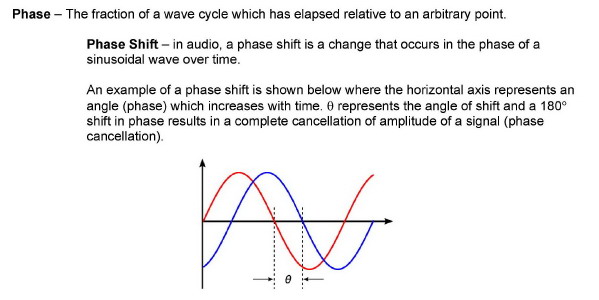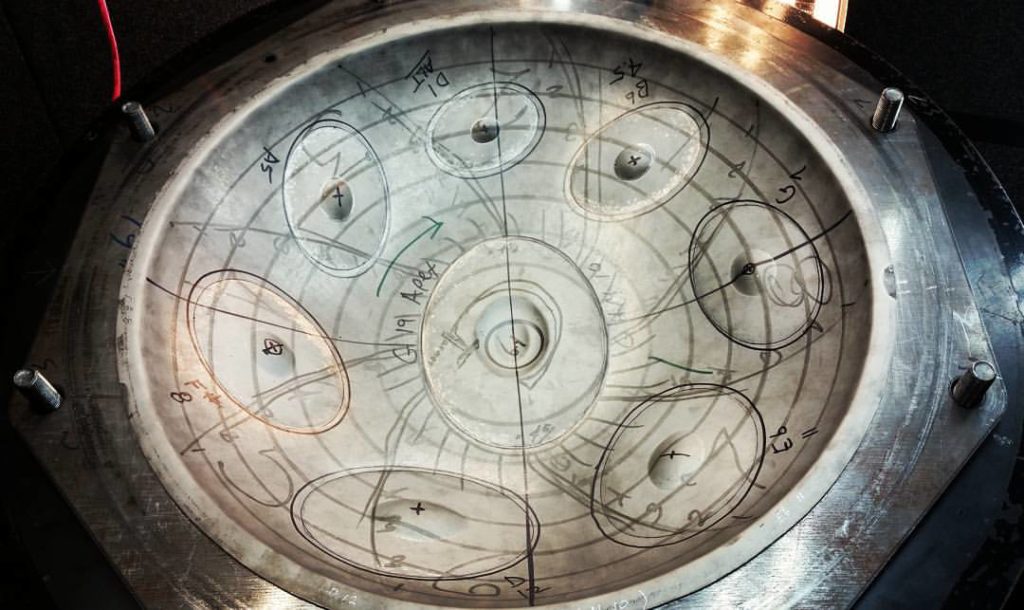In Stock and Custom Order Handpans for sale
Problem of Wave Interference in Steel Vibration
A common struggle for singing steel tuners is dealing with certain frequencies that are impossible to stabilize. There appears to be multiple reasons why this can happen. One reason that is covered in another post is wave interference in the resonance of a chamber. Another reason that we have found appears to be due to wave interference within the vibration of the steel. When different notes share the same frequencies and are in close proximity on the drum, wave interference appears to be increasingly likely. One note is activating another note, which then reactivates the first note. When both notes start emanating the same frequency in close proximity, there can be an inherent wobble if the two wave forms do not align appropriately within the steel vibration. We have seen this dynamic lead to as little as a 2-5 cent wobble or as much as a 30-40 cent wobble across different builder’s instruments.
How to deal with the Problem
Some tuners accept a little wobble that many players are unlikely to notice while other tuners detune frequencies to find the best place between stabilization and too far out of tune when this situation occurs. The dynamic is often stronger and more obvious on material and shaping methods that inherently lead toward greater activation while the dynamic is sometimes weaker on material and shaping methods that lead toward more controlled and muffled drums. Heat treating recipes, stress relieving, note border and interstitial design can also significantly effect this interaction of vibrating waves.
Avoiding the Problem
Within our current building methods, this dynamic has lead us to simply avoid the scenario whenever possible by not offering scales in certain layouts and orienting our notes in certain directions as is common in Steel Pan architecture. After many years of building the Saraz across multiple materials, shaping methods and designs, we have found that this situation is common in at least four scenarios.
Adjacent fifth scale degrees
When two notes are aside each other that are a fifth scale degree apart, they will share a similar harmonic if each note is tuned with the typical octave and compound fifth. An example is having an A3 and E4 aside each other as side notes on a handpan. Each note has an E5 harmonic. It is the compound fifth harmonic of the A3 and the octave harmonic of the E4. We have found that about 80% of the time, at least one and sometimes both of these notes will have a slight wobble, specifically due to the harmonics creating wave inference within the vibration of the steel between each note. When the two adjacent notes are lower in the scale, the wobble tends to be 2-4 beats per second while when the two adjacent notes are higher in the scale, the wobble tends to be much faster. This seems to mostly only happen when the two notes are adjacent. If these two notes are across the drum from each other or have another note between them, the wave interference does not seem to happen nearly as often.
A common scale form that typically has an adjacent fifth scale degree is the Pygmy scale, which is a pentatonic minor scale. Because of this inherent wave inference, we simply do not offer any layouts of the Pygmy scale. While this situation often occurs on pentatonic scales, there are some pentatonic layouts that avoid it. Although we do not offer the Pygmy scale, we offer numerous hexatonic minor scales that add one additional note positioned so that it eliminates the adjacent fifth scale degree from happening in the layout. This also gives the player one additional note to explore in the minor scale. If the player wishes to play the Pygmy scale, all the player has to do is leave out the additional note of the scale.
Center note harmonics and side notes
Another situation where we have found that wave inference can happen in the vibration of the steel is between the center note harmonics and side notes that share the same frequencies. For example, a G3 center note tuned with a traditional G4 octave harmonic and D5 compound fifth harmonic might create wave interference with the fundamentals of G4 and D5 sides notes. This is much more likely to happen if for example the G4 fundamental side note is near or pointing toward the G4 octave harmonic of the center note. Similarly, if the D5 fundamental side note is near or pointing at the D5 compound fifth of the center note, wave inference is more likely to happen. The same can also be true with a D4 if it is pointed toward the D5 compound fifth harmonic of the center note because the D4 side note has a D5 octave harmonic.
This is the primary reason that we turn certain notes more parallel to the rim of the drum and away from the center note. These side notes are the notes that also have the same frequency as the center note harmonics. Additionally, we always try to position the center note so that its harmonics are emanating 90 degrees away from the side note with the same frequency. When considering the angle of all emanating frequencies, we tend to position our notes so that similar frequencies are emanating parallel to each other instead of emanating toward each other. While turning a side note toward the rim takes up far more space, we have found that it is a worthy trade for consistently more wave stability in the sustain of notes that tend to activate each other and lead to wave interference if not positioned in this way.
Shoulder tones and harmonics of side notes
Another place we have found wave interference is between tuned shoulder tones of the center note and harmonics of side notes. This is basically the same dynamic as the other two situations above. Depending on what frequencies the shoulder tones are tuned to and which notes are closest to them, there can be wave interference. An example is a C#3 center note with a C#6 tuned shoulder tone. If there is a C#5 fundamental with a C#6 octave harmonic near the position of the tuned shoulder, it can lead toward wave interference. Of the four examples listed, we find that this situation is the least common, however it does occasionally happen. At Saraz, we tend to detune our shoulder tones approximately 10-20 cents because when they are perfectly in tune, they tend to scream and sometimes dominate the drum with a bit more brightness than we desire. This detuning is likely the reason why we do not experience wave interference very often between our tuned shoulder tones and sides notes.
Port tuning of the fundamental
At Saraz, we typically tune the fundamental and two different harmonics into our ports. The other harmonics are typically a third scale degree and a fifth scale degree of the port fundamental, which creates a chord. A common example of a Saraz port tuning is E5 fundamental with G5 and B5 harmonics. We tend to find generally great wave stability with the port harmonics, however the port fundamental can create significant problems. The wave form of the port fundamental seems to be a strange animal relative to any other frequency on a Handpan. If there is a note membrane fundamental with the same frequency anywhere on the drum, it will tend to have horrible wave interference. For example, if the port is tuned with a D5 fundamental and there is a D5 note membrane fundamental anywhere on the drum, the note membrane will have wave interference and an inherent wobble that is very noticeable.
Often the port fundamental also influences other notes with a harmonic that is the same frequency. For example if there is an E5 port fundamental, it will often create a bit of wave interference and wobble on an E4 note with an E5 octave harmonic. This is often not noticed if the drum is played in the lap because the player’s legs are muffling the port, however it becomes more noticeable when the drum is played vertically or put in a stand where the port can freely resonate. At Saraz, we do not offer any bottom notes with harmonics that share the same frequency as the port fundamental because the wave interference tends to be much stronger than for notes on the top shell. We also often detune the port fundamental approximately 15 cents to decrease the amount of coupling between it and other notes with the same frequency. Some builders have avoided this dynamic by tuning a port fundamental lower than any note on the drum. One example is to tune a D3 or Eb3 port fundamental on an drum where the lowest note membrane is an F3.
Scale layout design
People often ask us for scale layouts that we do not offer. The four scenarios explained above in addition to Resonance Wave Interference are the primary reasons why we only offer certain Scale Layouts and do not build other scale layouts that we know are likely to lead to inherent wave interference. We feel that avoiding wave interference dynamics when possible in the architecture leads toward an drum with inherently greater wave stability and therefore higher quality.









